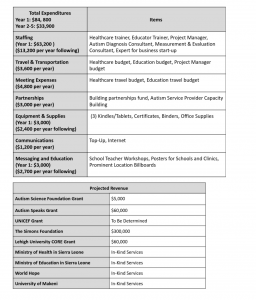Our general financial model can be seen in the table below. This represents our realistic estimates for expenditures and the current streams of revenue available to us. This creates total expenditures of $84800 in the first year of our venture and $33900 in years 2-5 of our venture. Our main sources of projected revenue come from grants including: Autism Speaks Grant, Autism Science Foundation Grant, Simons Foundation, Lehigh University CORE Grant, and the Davis Peace Projects Grant.
A more optimistic estimate for our steady state over the coming years involves more grants and projected revenue becoming available to us. This also involves lower cost for staffing and equipment as prices fluctuate and stronger relationships with our partners provide resources we would otherwise have to pay for. A pessimistic view of our steady-state involves the opposite, and we would see very few grants adding to our revenue and no change in costs, or potentially even greater costs.
It is difficult to create a financial model, as we are not selling a product for profit. We hope to get a better understanding of costs and resources when we go to Sierra Leone this summer.
In the context of our venture, our success is not measured by sales but by the number of children in Sierra Leone screened for autism using our screener. Our goal is to have 100% of children screened for autism by 2026, by expanding the use of the screener, training, and staffing to an increasing number of districts as our venture progresses. In the next two years, a realistic outlook/reach projection of our success would be 40% of children screened. In 2022, we aim to screen children in Bombali, Port Loko, and Kambia districts. By 2023, our reach would expand to include both the urban and rural Western Area regions. These projections are dependent on the success of our field work and working on improving the validity of our screener over the course of this summer and into the next semester. We also plan to train three healthcare workers at each healthcare facility and three teachers per school to administer and interpret the screener. These trainings follow the same reach projections as the use of the screener itself. Optimistically, our screener will be developed in a timely manner and we will be able to reach this goal, as well as possibly expand to more districts in a faster manner. From a pessimistic perspective, if work on the screener does not go as planned, or we run into unexpected delays, our reach projection for use of our screener may be delayed.

